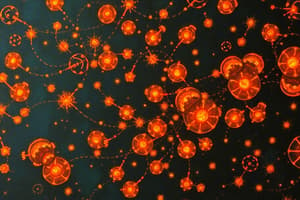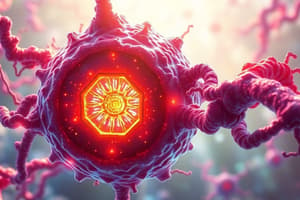Podcast
Questions and Answers
What is the first stage of the cell signaling process?
What is the first stage of the cell signaling process?
- Transduction
- Response
- Activation
- Reception (correct)
Which of the following best describes the function of kinases in signal transduction?
Which of the following best describes the function of kinases in signal transduction?
- They dephosphorylate proteins to inhibit signaling.
- They bind signaling molecules to receptors.
- They phosphorylate proteins to activate signaling pathways. (correct)
- They transport signaling molecules across the cell membrane.
What role do second messenger molecules play in signal transduction?
What role do second messenger molecules play in signal transduction?
- They deliver signals outside the cell.
- They convert extracellular signals to an intracellular response. (correct)
- They are responsible for the initial detection of signals.
- They serve as receptors for external signals.
Which statement accurately describes the sequence of events in signal transduction?
Which statement accurately describes the sequence of events in signal transduction?
What happens during the reception stage of cell signaling?
What happens during the reception stage of cell signaling?
What is the primary role of protein kinases in phosphorylation cascades?
What is the primary role of protein kinases in phosphorylation cascades?
Which of the following best describes the action of phosphatase enzymes?
Which of the following best describes the action of phosphatase enzymes?
In a phosphorylation cascade, what triggers the activation of the first protein kinase?
In a phosphorylation cascade, what triggers the activation of the first protein kinase?
What is the sequence of activation in a typical phosphorylation cascade?
What is the sequence of activation in a typical phosphorylation cascade?
How does the phosphorylation of a protein typically affect its activity?
How does the phosphorylation of a protein typically affect its activity?
What role does cAMP play in cellular signaling?
What role does cAMP play in cellular signaling?
Which of the following accurately describes a secondary messenger?
Which of the following accurately describes a secondary messenger?
What is the first step in the cellular signaling process?
What is the first step in the cellular signaling process?
How does the activation of G-proteins occur?
How does the activation of G-proteins occur?
What happens to proteins during phosphorylation in signaling pathways?
What happens to proteins during phosphorylation in signaling pathways?
Which molecule is primarily involved in signal amplification in G-protein pathways?
Which molecule is primarily involved in signal amplification in G-protein pathways?
In the context of cellular responses, what initiates the activation of cellular functions?
In the context of cellular responses, what initiates the activation of cellular functions?
What is a common function of relay molecules in signal transduction pathways?
What is a common function of relay molecules in signal transduction pathways?
What is the primary function of receptors in cell signaling?
What is the primary function of receptors in cell signaling?
Which process is primarily highlighted during the transduction stage of cell signaling?
Which process is primarily highlighted during the transduction stage of cell signaling?
What is the role of second messengers in signal transduction pathways?
What is the role of second messengers in signal transduction pathways?
Which of the following is a feature of multistep signal transduction pathways?
Which of the following is a feature of multistep signal transduction pathways?
What form of modifications do proteins typically undergo during the transduction process?
What form of modifications do proteins typically undergo during the transduction process?
How are signaling proteins categorized?
How are signaling proteins categorized?
What is typically a consequence of amplifying a signal in a cell signaling pathway?
What is typically a consequence of amplifying a signal in a cell signaling pathway?
What is the significance of conformational changes in proteins during signal transduction?
What is the significance of conformational changes in proteins during signal transduction?
What is primarily regulated in a cell as a result of signaling responses?
What is primarily regulated in a cell as a result of signaling responses?
Which of the following describes how the same ligand can cause different cellular responses?
Which of the following describes how the same ligand can cause different cellular responses?
What is the role of pathway branching in cell signaling?
What is the role of pathway branching in cell signaling?
Which of the following best explains the concept of specificity in cell signaling?
Which of the following best explains the concept of specificity in cell signaling?
What cellular process can be activated as a response to cell signaling?
What cellular process can be activated as a response to cell signaling?
How does phosphorylation play a role in cell signaling?
How does phosphorylation play a role in cell signaling?
What could be a possible outcome of a signal transduction pathway?
What could be a possible outcome of a signal transduction pathway?
What does a conformational change in a receptor signify?
What does a conformational change in a receptor signify?
What determines the specific response of a cell to a signaling molecule?
What determines the specific response of a cell to a signaling molecule?
Which type of receptor directly facilitates the rapid transmission of signals across synapses?
Which type of receptor directly facilitates the rapid transmission of signals across synapses?
How do G-protein-linked receptors primarily effect cellular signaling?
How do G-protein-linked receptors primarily effect cellular signaling?
What is a possible outcome when multiple receptors are triggered by the same signal?
What is a possible outcome when multiple receptors are triggered by the same signal?
What is the role of relay molecules in cell signaling?
What is the role of relay molecules in cell signaling?
What is the ultimate goal of signaling pathways in cells?
What is the ultimate goal of signaling pathways in cells?
What characterizes enzyme-linked receptors in signaling?
What characterizes enzyme-linked receptors in signaling?
Which statement is FALSE about signal termination in cellular response?
Which statement is FALSE about signal termination in cellular response?
Flashcards
Cell Signaling
Cell Signaling
The process by which a cell detects and responds to a signal from its environment.
Signal Transduction Pathway
Signal Transduction Pathway
The three stages a cell goes through to process a signal: reception, transduction, and response.
Reception
Reception
The binding of a signaling molecule to a receptor protein on a cell's surface, triggering a change in the receptor's shape.
Transduction
Transduction
Signup and view all the flashcards
Response
Response
Signup and view all the flashcards
Signal Reception
Signal Reception
Signup and view all the flashcards
Signal Transduction
Signal Transduction
Signup and view all the flashcards
Signaling Proteins
Signaling Proteins
Signup and view all the flashcards
Second Messengers
Second Messengers
Signup and view all the flashcards
Kinases
Kinases
Signup and view all the flashcards
Phosphatases
Phosphatases
Signup and view all the flashcards
Protein Phosphorylation
Protein Phosphorylation
Signup and view all the flashcards
Protein Dephosphorylation
Protein Dephosphorylation
Signup and view all the flashcards
Phosphorylation Cascade
Phosphorylation Cascade
Signup and view all the flashcards
Phosphatase Enzymes
Phosphatase Enzymes
Signup and view all the flashcards
Why is Protein Phosphorylation/Dephosphorylation important?
Why is Protein Phosphorylation/Dephosphorylation important?
Signup and view all the flashcards
Ligand
Ligand
Signup and view all the flashcards
Specificity of Cell Signaling
Specificity of Cell Signaling
Signup and view all the flashcards
The Specificity of the Signal
The Specificity of the Signal
Signup and view all the flashcards
G-Protein
G-Protein
Signup and view all the flashcards
First Messenger
First Messenger
Signup and view all the flashcards
G-Protein Coupled Receptor
G-Protein Coupled Receptor
Signup and view all the flashcards
Adenylyl Cyclase
Adenylyl Cyclase
Signup and view all the flashcards
cAMP (Cyclic AMP)
cAMP (Cyclic AMP)
Signup and view all the flashcards
Signal Deactivation
Signal Deactivation
Signup and view all the flashcards
Signal Molecule
Signal Molecule
Signup and view all the flashcards
Receptor Protein
Receptor Protein
Signup and view all the flashcards
Relay Molecule
Relay Molecule
Signup and view all the flashcards
Cellular Response
Cellular Response
Signup and view all the flashcards
Ion Channel-linked Receptor
Ion Channel-linked Receptor
Signup and view all the flashcards
G-Protein-linked Receptor
G-Protein-linked Receptor
Signup and view all the flashcards
Enzyme-linked Receptor
Enzyme-linked Receptor
Signup and view all the flashcards
Study Notes
Session Learning Outcomes (SLOs)
- SLO# 3: Describe the stages and events of cell signaling.
- SLO# 1: Define kinases and phosphatases and their role in signal transduction.
The Three Stages of Cell Signaling
- Cells receiving signals undergo three processes: Reception, Transduction, and Response.
- Signal transduction: the cell's ability to translate receptor-ligand interaction into changes in behavior or gene expression. This is called the signal transduction pathway.
Signal Transduction Pathway
- Function: converting extracellular information into an appropriate cellular response.
- Composed of: signals, receptors, signaling proteins, and second messenger molecules.
- Membrane-permeable signal molecules bind to receptor proteins in the cytosol.
- Membrane-impermeable signal molecules bind to transmembrane cell surface receptor proteins.
- Signaling proteins and second messengers amplify, process, and distribute incoming signals.
- Some signals are sent to effector proteins in the cytosol for faster, short-lived responses.
- Some pathways terminate at effectors in the nucleus, which are transcription factors controlling gene expression for slower, prolonged responses.
Protein Phosphorylation and Dephosphorylation
- Many signal pathways include phosphorylation cascades.
- Protein kinases add a phosphate group to the next protein in line, activating it.
- Phosphatase enzymes remove the phosphate groups to inactivate the proteins.
Intracellular Signaling Proteins
- Intracellular signaling proteins propagate signals within a cell.
- Signaling proteins rapidly transmit and amplify signal information.
- As information passes through a signal transduction pathway, it can often change physical form.
- Signaling proteins are grouped into six classes based on their structure, location, and mechanism of signal transmission.
- Second messengers are non-protein molecules linking signaling proteins in signal transduction pathways.
Small Molecules and Ions as Second Messengers
- Secondary messengers are small, non-protein, water-soluble molecules or ions acting as messengers.
- Examples include cAMP, cGMP, and calcium ions.
Termination of the Signal
- Signal responses are terminated quickly by reversing ligand binding.
Types of Receptors
- In contrast to NO and hormones, hydrophobic signal molecules can cross the plasma membrane.
- Most cell surface receptor proteins belong to one of three large families: ion channel-linked receptors, G-protein-linked receptors, and enzyme-linked receptors.
Ion-Channel-Linked Receptors
- Function as the simplest and direct way for cell-surface receptors.
- These receptors are responsible for rapid transmissions of signals across synapses in the nervous system.
- When neurotransmitter binds, this type of receptor alters its conformation to open or close channels for ion flow (like Na+, K+, Ca2+).
G-Protein-Linked Receptors
- Activate a class of membrane-bound proteins.
- The binding of a signal to the receptor changes the conformation of the receptor, triggering the activation of the G-protein.
Enzyme-Linked Receptors
- Act as an enzyme or are associated with enzymes inside the cell.
- The binding of a signal to the receptor activates its catalytic domain, initiating a cascade of biochemical reactions.
Specificity of Cell Signaling
- A signaling molecule binds to its receptor, changing the receptor's shape and causing a cellular response.
- The same ligand can bind to the same receptor on different cell types, leading to different responses.
- Different ligands binding to different receptors can produce the same cellular response.
- Different cell types have different collections of proteins, leading to their specific responses to signals.
- Pathway branching and "cross-talk" help coordinate incoming signals within the cell.
Response-Cell Signaling
- Response- signaling leads to regulation of transcription (turning genes on/off) or cytoplasmic activities.
- Many responses are possible: catalysis by an enzyme, cytoskeleton rearrangement, or activation of specific genes.
Studying That Suits You
Use AI to generate personalized quizzes and flashcards to suit your learning preferences.
Related Documents
Description
Test your knowledge on the stages and mechanisms of cell signaling and signal transduction. This quiz covers key concepts such as kinases, second messengers, and phosphorylation cascades. Assess your understanding of how these processes regulate cellular communication.




